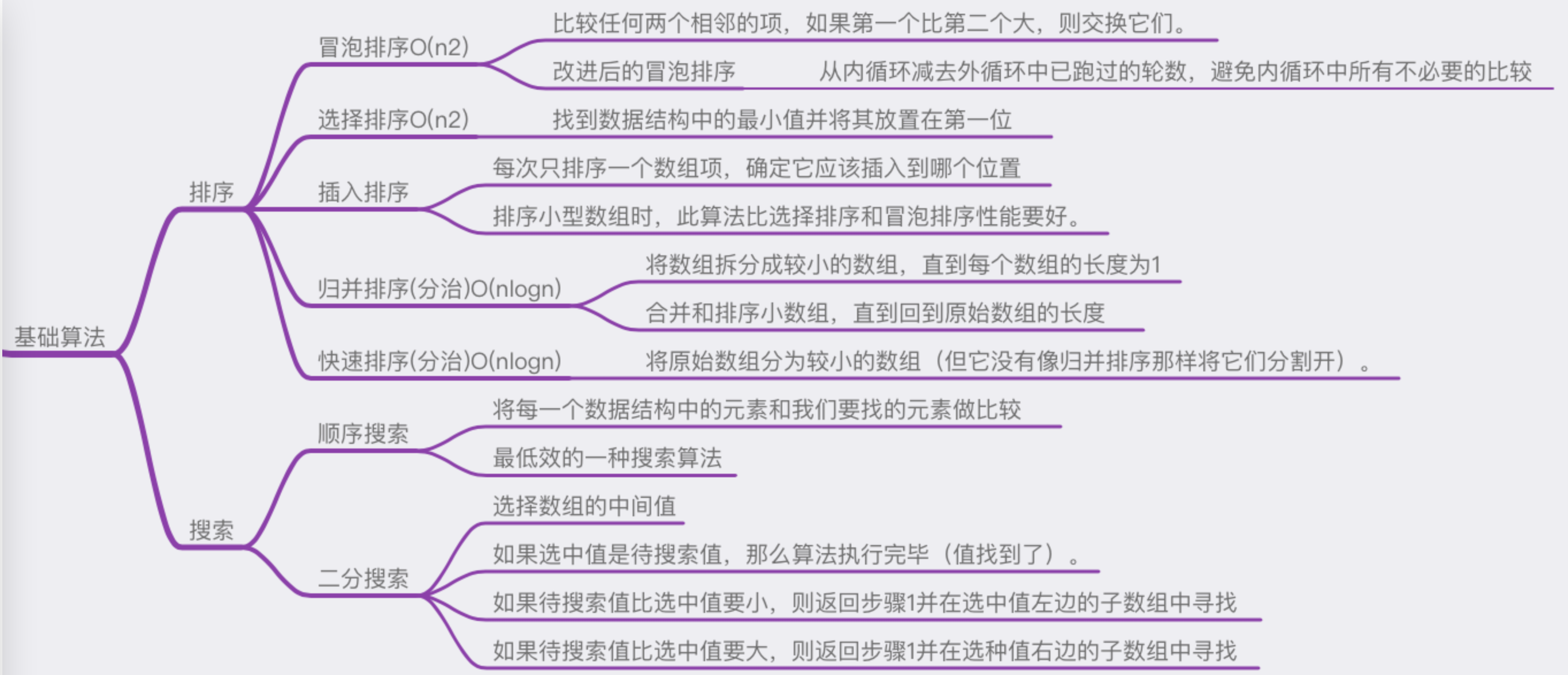function ArrayList() {
let array = [];
this.insert = (item) => {
array.push(item);
};
this.toString = () => {
return array.join();
};
// 先定义一个内部swap方法 用于交换数组中的两个值
// 注意,只能用在ArrayList内部
const swap = function (index1, index2) {
const aux = array[index1];
array[index1] = array[index2];
array[index2] = aux;
};
}比较任意两个相邻的项,如果第一个比第二个大,则交换顺序
var bubbleSort = function () {
const len = array.length;
for (let i = 0; i < len; i++) {
for (let j = 0; j < len - 1; j++) {
if (array[j] > array[j + 1]) {
swap(j, j + 1);
}
}
}
};改进一下,从内循环中减去外循环中已跑过的轮数
var modifiedBubbleSort = function () {
const len = array.length;
for (let i = 0; i < len; i++) {
// 看这里j < len - 1 - i
for (let j = 0; j < len - 1 - i; j++) {
if (array[j] > array[j + 1]) {
swap(j, j + 1);
}
}
}
};找到数组中最小的项并将其放到第一位,找到第二小的值,并将其放到第二位,依次……
var selectionSort = function () {
const len = array.length;
let indexMin; // 最小值下标
for (let i = 0; i < len - 1; i++) {
// 假设当前遍历的是最小值
indexMin = i;
// 前面已经拍过序的不用再循环了
for (let j = i; j < len; j++) {
// 依次比较,交换最小值下标
if (array[indexMin] > array[j]) {
indexMin = j;
}
}
// 如果找到的最小值跟原来设定的最小值不一样,交换其值
if (i !== indexMin) {
swap(i, indexMin);
}
}
};每次只排序一个数组项,确定它应该插入到哪个位置
var insertionSort = function () {
let j, temp;
// 默认第一项已经排序,所以从第二项开始
for (let i = 1; i < a.length; i++) {
// 辅助变量和值,存储当前下标和值
j = i;
temp = a[i];
// 一直跟前一项比较,直到找到正确的位置插入
while (j > 0 && a[j - 1] > temp) {
// 移到当前位置
a[j] = a[j - 1];
j--;
}
a[j] = temp;
}
};- 将数组拆分成较小的数组,直到每个数组的长度为1;
- 合并和排序小数组,直到回到原始数组的长度;
var mergeSort = function () {
// 递归的停止条件
if (array.length == 1) {
return array;
}
// 中间值取整,分成两个小组
var middle = Math.floor(array.length / 2),
left = array.slice(0, middle),
right = array.slice(middle);
// 递归,对左右两部分数据进行合并排序
return merge(mergeSort(left), mergeSort(right));
};
function merge(left, right) {
var result = [];
while (left.length > 0 && right.length > 0) {
// 比较左边的数组的值是否被右边的小
if (left[0] < right[0]) {
result.push(left.shift());
} else {
result.push(right.shift());
}
}
return result.concat(left).concat(right);
}- 从数组中选择中间项目作为主元
- 建立左右两个数组,分别存储左边和右边的数组
- 利用递归进行下次比较
var quickSort = function () {
if (array.length <= 1) {
return array;
}
// 取中间数作为基准索引,浮点数向下取整
var index = Math.floor(array.length / 2);
// 取得该值
var pivot = array.splice(index, 1);
// 分别建立左右空数组,作为push所用
var left = [];
var right = [];
for (var i = 0; i < array.length; i++) {
// 基准左边的传到左数组,右边的传到右数组
if (array[i] < pivot) {
left.push(array[i]);
} else {
right.push(array[i]);
}
}
// 不断递归重复比较
return quickSort(left).concat(pivot, quickSort(right));
};将每一个数据结构中的元素和我们要找的元素做比较 最低效的一种搜索算法
var sequentialSearch = function (item) {
for (let i = 0; i < array.length; i++) {
if (item === array[i]) {
return i;
}
}
return -1;
};- 选择数组的中间值
- 如果选中值是待搜索值,那么算法执行完毕(值找到了)。
- 如果待搜索值比选中值要小,则返回步骤1并在选中值左边的子数组中寻找
- 如果待搜索值比选中值要大,则返回步骤1并在选种值右边的子数组中寻找
var binarySearch = function (item) {
// 先将数组进行排序
this.quickSort();
let low = 0, hight = array.length - 1, mid, element;
while (low <= high) {
// 取中间值
mid = Math.floor((low + high) / 2);
element = array[mid];
if (element < item) {
low = mid + 1;
} else if (element > item) {
high = mid - 1;
} else {
return mid;
}
}
return -1;
};